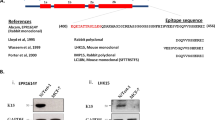Summary
A sequential double immunoenzymic staining procedure was developed using the monoclonal antibody anti-BrdUrd and Ki67 in order to determine whether hyperproliferative skin disorders, such as psoriasis, are characterized by an increased growth fraction rather than a much shorter cell cycle time of all germinative cells. Ki67 binds to a proliferation-associated nuclear antigen in a variety of human cell types, and anti-BrdUrd can be used to identify DNA-synthesizing cells. Although in hyperproliferative epidermis the absolute numbers of BrdUrd-positive cells as well as Ki67-positive cells were grossly increased, the ratio of these values was not changed compared to the ratio found in the epidermis of the clinically uninvolved skin of psoriatic patients and in normal epidermis. This suggests an increased growth fraction in hyperproliferative epidermis.
Our data show that immunohistochemical double-staining techniques can be a valuable tool in the study of cell cycle kinetics in epithelial tissues.
Similar content being viewed by others
References
BAUER, F. W. (1986) Cell kinetics. InTextbook of Psoriasis (edited by MIER, P. D. & VAN DE KERKHOF, P. C. M.), pp. 100–13. Edinburgh, London, Melbourne, New York: Churchill Livingstone.
BAUER, F. W. & DE GROOD, R. M. (1976) Improved technique for epidermal cell cycle analysis.Brit. J. Dermatol. 95, 565–6.
BOEZEMAN, J. B. M., BAUER, F. W. & DE GROOD, R. M. (1987) Flow cytometric analysis of the recruitment of G0 cells in human epidermisin vivo following tape stripping.Cell Tissue Kinet. 20, 99–107.
BURGER, P. C., SHIBATA, T. & KLEIHUES, P. (1986) The use of the monoclonal antibody Ki-67 in the identification of proliferating cells: application to surgical neuropathology.Amer. J. Surg. Pathol. 10, 611–17.
GERDES, J., SCHWAB, U., LEMKE, H. & STEIN, H. (1982) Production of a mouse monoclonal antibody reactive with a human nuclear antigen associated with cell proliferation.Int. J. Cancer 31, 13–20.
GERDES, J., LEMKE, H., BAISCH, H., WACKER, H., SCHWAB, U. & STEIN, H. (1984) Cell cycle analysis of a cell proliferation-associated human nuclear antigen defined by the monoclonal antibody Ki-67.J. Immunol. 133, 1710–15.
GRATZNER, H. G. (1982) Monoclonal antibody to 5-bromo and 5-iododeoxyuridine: a new reagent for detection of DNA replication.Science 218, 474–6.
GUNDUZ, N. (1985) The use of FITC-conjugated monoclonal antibodies for determination of S-phase cells with fluorescence microscopy.Cytometry 6, 597–601.
LANE, E. B., BARTEK, J., PURKIS, P. E. & LEIGH, I. M. (1985) Keratin antigens in differentiating skin.Ann. N. Y. Acad. Sci. 455, 241–58.
LANGER, E.-M., RÖTTGERS, H. R., SCHLIERMANN, M. G., MEIER, E.-M., MILTENBURGER, H. G., SCHUMANN, J. & GÖHDE, W. (1985) Cycling S-phase cells in animal and spontaneous tumours. I. comparison of the BrdUrd and3H-thymidine techniques and flow cytometry for the estimation of S-phase frequency.Acta Radiol. Oncol. 24, 545–8.
LEIGH, I. M., PULFORD, K. A., RAMAEKERS, F. C. S. & LANE, E. B. (1985) Psoriasis: maintenance of an intact monolayer basal cell differentiation compartment in spite of hyperproliferation.Brit. J. Dermatol 113, 53–64.
LELLE, R. J., HEIDENREICH, W., STAUCH, G., WECKE, I. & GERDES, J. (1987) Determination of growth fractions in benign breast disease (BBD) with monoclonal antibody Ki-67.J. Cancer Clin. Oncol. 113, 73–7.
RIJZEWIJK, J. J., VAN ERP, P. E. J., BOEZEMAN, J. B. M., DE JONGH, G. & BAUER, F. W. (1989) The development of the bromodeoxyuridine technique for kinetic studies in human epidermis.Epithelia, in press.
RIJZEWIJK, J. J., BOEZEMAN, J. B. M. & BAUER, F. W. (1988) Synchronized growth in human epidermis following tape-stripping: its implication for cell kinetic studies. Cell Tissue kinet.21, 227–9.
VAN ERP, P. E. J., GROENENDAL, H., BAUER, F. W. & RIJZEWIJK, J. J. (1987) Growth fraction in epidermal skin disorders determined by the monoclonal antibody Ki67.J. Invest. Dermatol. 89, 312.
WEINSTEIN, G. D., ROSS, P., MCCULLOUGH, J. L. & COLTON, A. (1983) Proliferative defects in psoriasis. InPsoriasis: Cell Proliferation (edited by WRIGHT, N. A. & CAMPLE-JOHN, R. S.), pp. 189–208. Edinburgh, London, Melbourne, New York: Churchill Livingstone.
WEINSTEIN, G. D., MCCULLOUGH, J. L. & ROSS, P. A. (1985) Cell kinetic basis for pathophysiology of psoriasis.J. Invest. Dermatol. 85, 579–83.
WRIGHT, N. & ALISON, A. (1984) Kinetic parameters in stratified squamous epithelia. InThe Biology of Epithelial Cell Populations, pp. 250–86. Oxford: Clarendon Press.
Author information
Authors and Affiliations
Rights and permissions
About this article
Cite this article
Van Erp, P.E.J., De Mare, S., Rijzewijk, J.J. et al. A sequential double immunoenzymic staining procedure to obtain cell kinetic information in normal and hyperproliferative epidermis. Histochem J 21, 343–347 (1989). https://doi.org/10.1007/BF01798497
Received:
Revised:
Issue Date:
DOI: https://doi.org/10.1007/BF01798497




